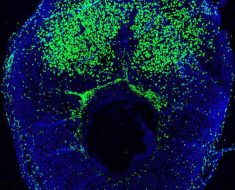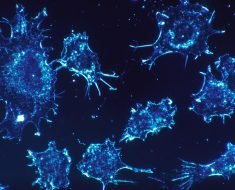Osteoarthritis is one of the most common causes of chronic pain in the world. More than 30 million people in the United States alone suffer from osteoarthritis, or OA, which can affect any moveable joint of the body, including the knees, hips and hands. OA normally manifests itself as a breakdown of joint tissues, including degradation of cartilage.
Better treatments for OA are dependent on a clear understanding of how it causes that pain—a question that isn’t simple, since cartilage has no neurons (nerve cells) to transmit pain signals. Now, an international research team led by an arthritis expert at Rush has shown that a peptide (molecule) produced when cartilage breaks down may drive OA-associated pain.
The researchers are the first to establish a link between the pain and the peptide, which is known as 32-mer, because it is composed of 32 amino acids (organic compounds that are the building blocks of proteins). They reported their discovery March 22 in JCI Insight, a publication of the Journal of Clinical Investigation.
“This is very exciting, because now we can target this process in our efforts to stop the pain,” said Dr. Anne-Marie Malfait, who led the project. Malfait is the George W. Stuppy, MD, Chair of Arthritis in Rush Medical College. Malfait and her collaborator and paper co-author, Dr. Amanda Fosang of the University of Melbourne, have grants from the National Institutes of Aging and the U.S. Department of Defense to explore treatments that might block the action of 32-mer in ailing joints.
“We wanted to explore the relationship between the pathological processes that are going on in the degenerating joint and how they relate to pain,” she said
When enzymes attack
When OA develops, enzymes in the joint attack aggrecan, a large molecule that is a key component of cartilage. These “aggrecanases”, as they’re called, split aggrecan at five distinct points, effectively destroying it.
“They chop up the core protein in aggrecan, and fragments of this huge molecule diffuse out of the cartilage,” Malfait said. “As a result, the cartilage loses its proper function.”
The peptide 32-mer is a by-product of this orchestrated enzymatic attack. Fosang previously discovered that it prompts a response from the immune system.
“Immune cells recognize danger signals in response to invaders like bacteria, but also to threats from pathological processes like joint degeneration under way inside the body,” Malfait said. “We decided to see if the 32-mer could be a link between the degenerating joint and the nerves that produce pain.”
Discovery may lead to new pain treatments
By comparing the results of a series of experiments in laboratory cultures and on genetically altered laboratory mice that develop OA, the researchers determined that the presence of 32-mer in joints resulted in pain, but only in mice that possessed a normal biochemical signaling pathway resulting from the activation of a receptor on pain-sensing neurons known as Toll-like receptor-2, or TLR2 for short. “That tells us that 32-mer is mediated in the joints through the TLR2 pathway,” Malfait said.
This finding will help researchers pinpoint the source of the pain of osteoarthritis, and work toward developing treatments aimed at relieving OA-associated pain. “This is a particularly pressing problem, as drugs that are widely used for the relief of pain in many circumstances such as opiates are problematic to use for chronic diseases like OA, owing to their potential for producing abuse and addiction,” Malfait said.
Finding an alternative to the current treatments for OA pain could both avoid a great deal of suffering and save a great amount of money. Treatment of osteoarthritis in the United States cost $130 billion in 2013 (the most recent year for which data is available), according to the federal Centers for Disease Control and Prevention.
Unless more effective, and more cost-effective treatments are found, that expense will increase dramatically by 2030, when nearly 70 million adults in the U.S. will have been diagnosed with some form of arthritis, according to the CDC.
Researchers also are looking for nerves that carry pain signals
However, blocking the action of 32-mer will not prevent osteoarthritis, the paper notes; the peptide is associated with the pain that accompanies the disease, not the degeneration of the joint itself. Malfait also said researchers still don’t know the precise location or type of nerve cells that are responsible for producing pain in response to 32-mer.
Source: Read Full Article





